Analysis of SONET, SDH, ATM, and MPLS in Data Communication
VerifiedAdded on 2020/04/21
|10
|2007
|135
Report
AI Summary
This report provides a comprehensive overview of key networking and data communication technologies, including SONET (Synchronous Optical Networking), SDH (Synchronous Digital Hierarchy), ATM (Asynchronous Transfer Mode), and MPLS (Multi-Protocol Label Switching). It details SONET's multiplexing capabilities using optical fiber, its various configurations, and its role in real-time data transfer. The report then explores SDH, its similarities and differences with SONET, and its application in global networks. ATM technology is examined for its virtual circuit switching, quality of service, and integration of various traffic types. Finally, the report analyzes MPLS, its Layer 2.5 network architecture, label switching, and benefits in accelerating packet routing over WANs. The report also includes diagrams and references to support the analysis of these technologies.
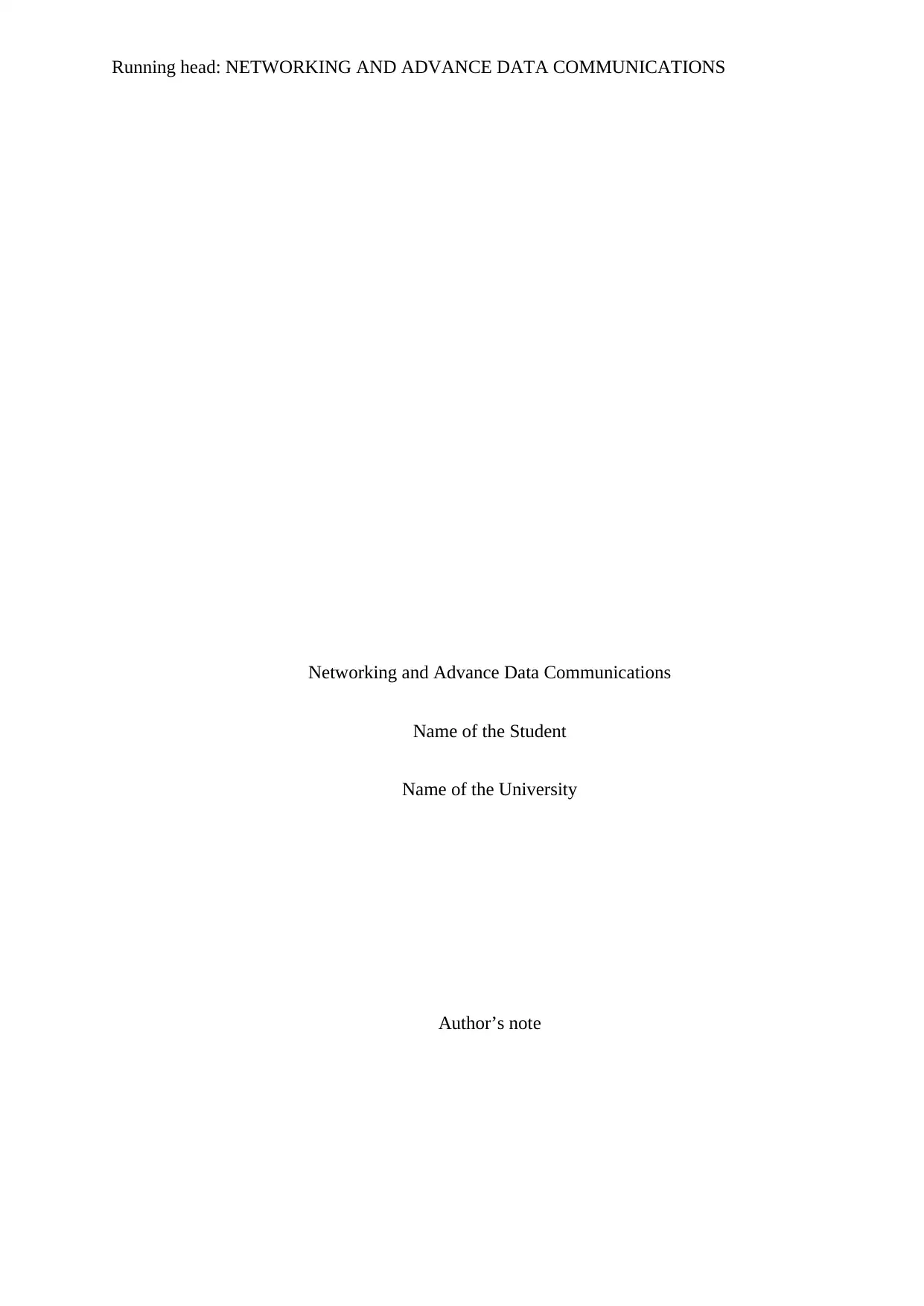
Running head: NETWORKING AND ADVANCE DATA COMMUNICATIONS
Networking and Advance Data Communications
Name of the Student
Name of the University
Author’s note
Networking and Advance Data Communications
Name of the Student
Name of the University
Author’s note
Paraphrase This Document
Need a fresh take? Get an instant paraphrase of this document with our AI Paraphraser

1NETWORKING AND ADVANCE DATA COMMUNICATIONS
Table of Contents
SONET.......................................................................................................................................1
SDH............................................................................................................................................2
ATM Technology.......................................................................................................................3
MPLS Technology.....................................................................................................................5
References..................................................................................................................................7
Table of Contents
SONET.......................................................................................................................................1
SDH............................................................................................................................................2
ATM Technology.......................................................................................................................3
MPLS Technology.....................................................................................................................5
References..................................................................................................................................7
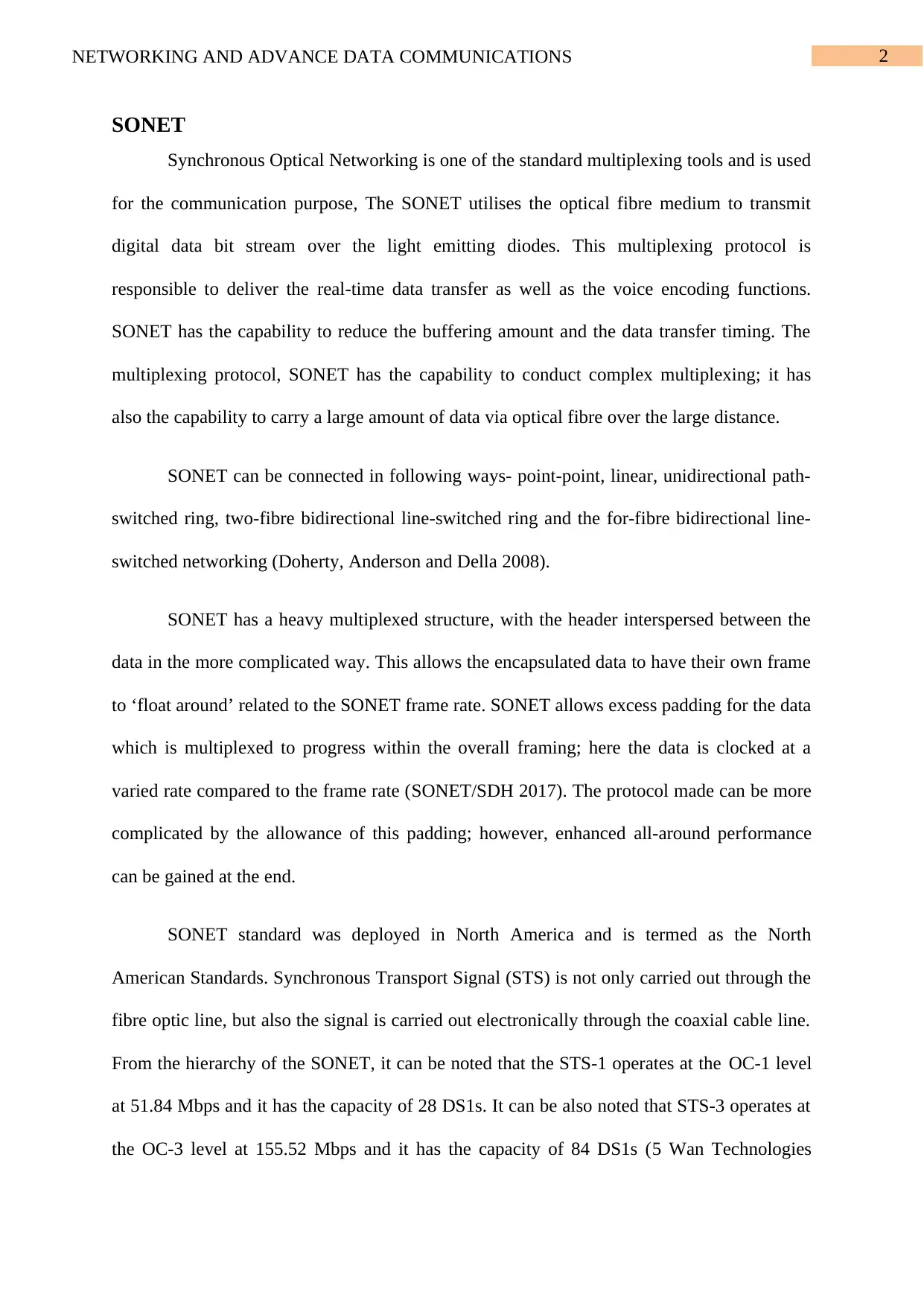
2NETWORKING AND ADVANCE DATA COMMUNICATIONS
SONET
Synchronous Optical Networking is one of the standard multiplexing tools and is used
for the communication purpose, The SONET utilises the optical fibre medium to transmit
digital data bit stream over the light emitting diodes. This multiplexing protocol is
responsible to deliver the real-time data transfer as well as the voice encoding functions.
SONET has the capability to reduce the buffering amount and the data transfer timing. The
multiplexing protocol, SONET has the capability to conduct complex multiplexing; it has
also the capability to carry a large amount of data via optical fibre over the large distance.
SONET can be connected in following ways- point-point, linear, unidirectional path-
switched ring, two-fibre bidirectional line-switched ring and the for-fibre bidirectional line-
switched networking (Doherty, Anderson and Della 2008).
SONET has a heavy multiplexed structure, with the header interspersed between the
data in the more complicated way. This allows the encapsulated data to have their own frame
to ‘float around’ related to the SONET frame rate. SONET allows excess padding for the data
which is multiplexed to progress within the overall framing; here the data is clocked at a
varied rate compared to the frame rate (SONET/SDH 2017). The protocol made can be more
complicated by the allowance of this padding; however, enhanced all-around performance
can be gained at the end.
SONET standard was deployed in North America and is termed as the North
American Standards. Synchronous Transport Signal (STS) is not only carried out through the
fibre optic line, but also the signal is carried out electronically through the coaxial cable line.
From the hierarchy of the SONET, it can be noted that the STS-1 operates at the OC-1 level
at 51.84 Mbps and it has the capacity of 28 DS1s. It can be also noted that STS-3 operates at
the OC-3 level at 155.52 Mbps and it has the capacity of 84 DS1s (5 Wan Technologies
SONET
Synchronous Optical Networking is one of the standard multiplexing tools and is used
for the communication purpose, The SONET utilises the optical fibre medium to transmit
digital data bit stream over the light emitting diodes. This multiplexing protocol is
responsible to deliver the real-time data transfer as well as the voice encoding functions.
SONET has the capability to reduce the buffering amount and the data transfer timing. The
multiplexing protocol, SONET has the capability to conduct complex multiplexing; it has
also the capability to carry a large amount of data via optical fibre over the large distance.
SONET can be connected in following ways- point-point, linear, unidirectional path-
switched ring, two-fibre bidirectional line-switched ring and the for-fibre bidirectional line-
switched networking (Doherty, Anderson and Della 2008).
SONET has a heavy multiplexed structure, with the header interspersed between the
data in the more complicated way. This allows the encapsulated data to have their own frame
to ‘float around’ related to the SONET frame rate. SONET allows excess padding for the data
which is multiplexed to progress within the overall framing; here the data is clocked at a
varied rate compared to the frame rate (SONET/SDH 2017). The protocol made can be more
complicated by the allowance of this padding; however, enhanced all-around performance
can be gained at the end.
SONET standard was deployed in North America and is termed as the North
American Standards. Synchronous Transport Signal (STS) is not only carried out through the
fibre optic line, but also the signal is carried out electronically through the coaxial cable line.
From the hierarchy of the SONET, it can be noted that the STS-1 operates at the OC-1 level
at 51.84 Mbps and it has the capacity of 28 DS1s. It can be also noted that STS-3 operates at
the OC-3 level at 155.52 Mbps and it has the capacity of 84 DS1s (5 Wan Technologies
⊘ This is a preview!⊘
Do you want full access?
Subscribe today to unlock all pages.

Trusted by 1+ million students worldwide
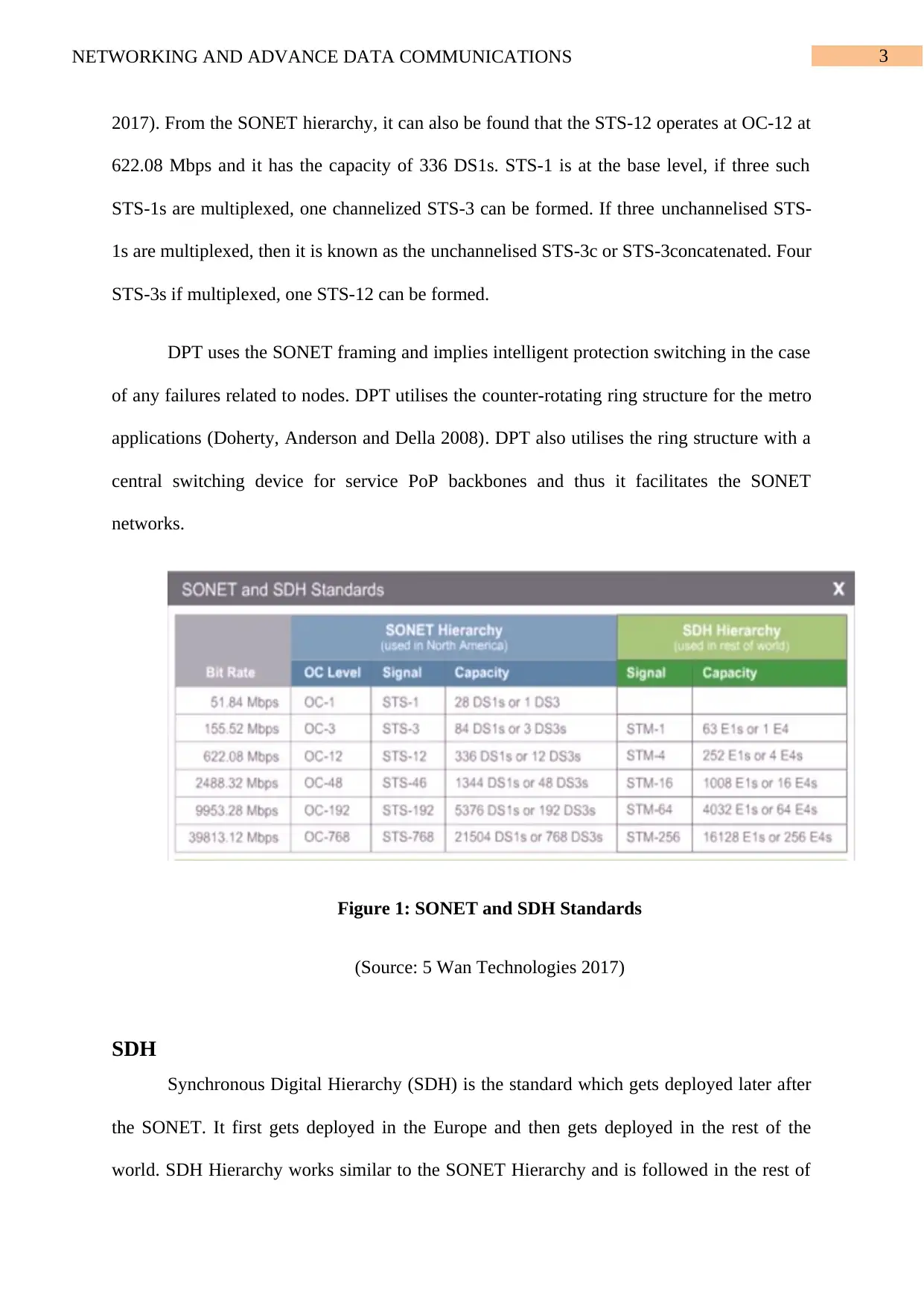
3NETWORKING AND ADVANCE DATA COMMUNICATIONS
2017). From the SONET hierarchy, it can also be found that the STS-12 operates at OC-12 at
622.08 Mbps and it has the capacity of 336 DS1s. STS-1 is at the base level, if three such
STS-1s are multiplexed, one channelized STS-3 can be formed. If three unchannelised STS-
1s are multiplexed, then it is known as the unchannelised STS-3c or STS-3concatenated. Four
STS-3s if multiplexed, one STS-12 can be formed.
DPT uses the SONET framing and implies intelligent protection switching in the case
of any failures related to nodes. DPT utilises the counter-rotating ring structure for the metro
applications (Doherty, Anderson and Della 2008). DPT also utilises the ring structure with a
central switching device for service PoP backbones and thus it facilitates the SONET
networks.
Figure 1: SONET and SDH Standards
(Source: 5 Wan Technologies 2017)
SDH
Synchronous Digital Hierarchy (SDH) is the standard which gets deployed later after
the SONET. It first gets deployed in the Europe and then gets deployed in the rest of the
world. SDH Hierarchy works similar to the SONET Hierarchy and is followed in the rest of
2017). From the SONET hierarchy, it can also be found that the STS-12 operates at OC-12 at
622.08 Mbps and it has the capacity of 336 DS1s. STS-1 is at the base level, if three such
STS-1s are multiplexed, one channelized STS-3 can be formed. If three unchannelised STS-
1s are multiplexed, then it is known as the unchannelised STS-3c or STS-3concatenated. Four
STS-3s if multiplexed, one STS-12 can be formed.
DPT uses the SONET framing and implies intelligent protection switching in the case
of any failures related to nodes. DPT utilises the counter-rotating ring structure for the metro
applications (Doherty, Anderson and Della 2008). DPT also utilises the ring structure with a
central switching device for service PoP backbones and thus it facilitates the SONET
networks.
Figure 1: SONET and SDH Standards
(Source: 5 Wan Technologies 2017)
SDH
Synchronous Digital Hierarchy (SDH) is the standard which gets deployed later after
the SONET. It first gets deployed in the Europe and then gets deployed in the rest of the
world. SDH Hierarchy works similar to the SONET Hierarchy and is followed in the rest of
Paraphrase This Document
Need a fresh take? Get an instant paraphrase of this document with our AI Paraphraser
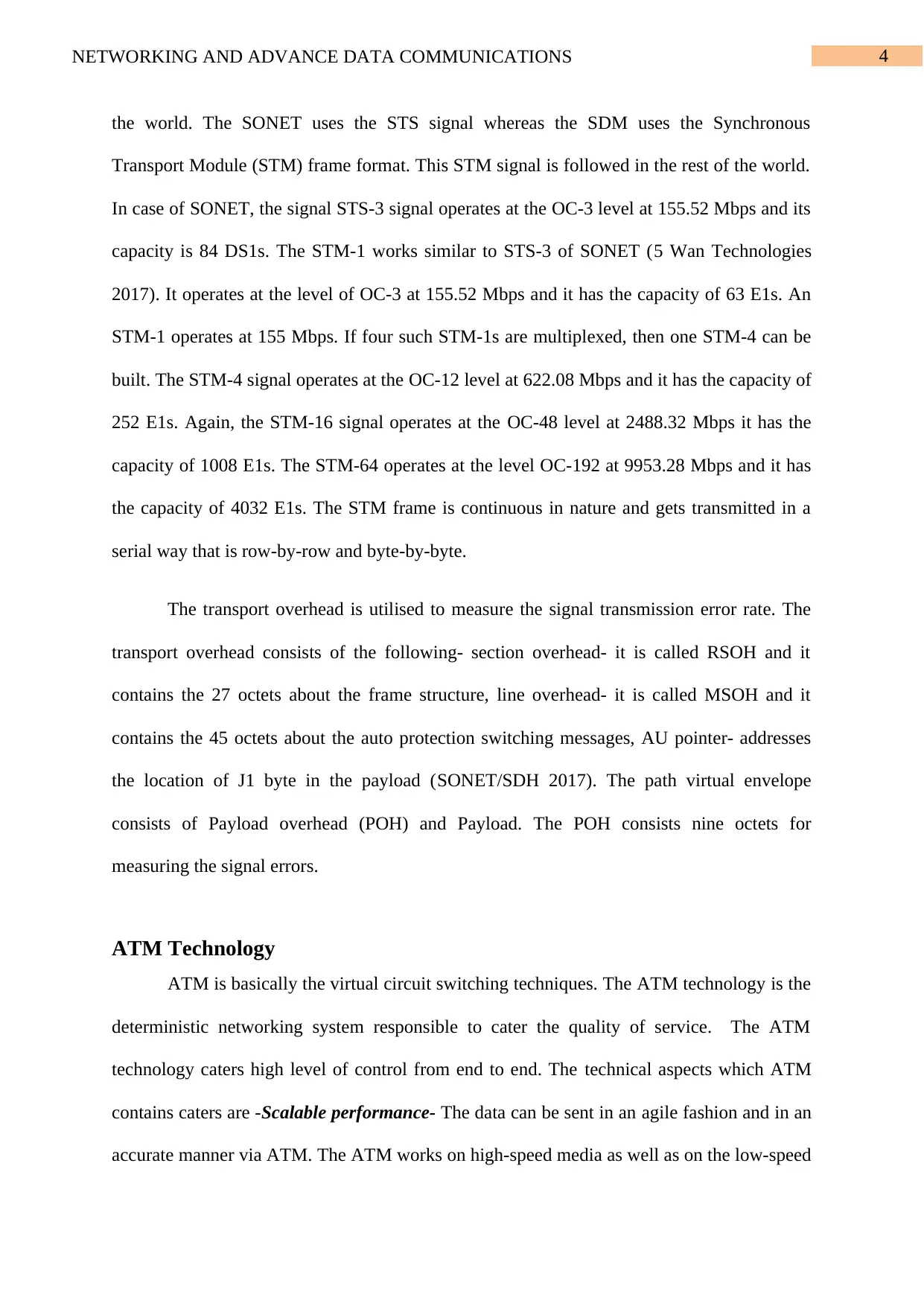
4NETWORKING AND ADVANCE DATA COMMUNICATIONS
the world. The SONET uses the STS signal whereas the SDM uses the Synchronous
Transport Module (STM) frame format. This STM signal is followed in the rest of the world.
In case of SONET, the signal STS-3 signal operates at the OC-3 level at 155.52 Mbps and its
capacity is 84 DS1s. The STM-1 works similar to STS-3 of SONET (5 Wan Technologies
2017). It operates at the level of OC-3 at 155.52 Mbps and it has the capacity of 63 E1s. An
STM-1 operates at 155 Mbps. If four such STM-1s are multiplexed, then one STM-4 can be
built. The STM-4 signal operates at the OC-12 level at 622.08 Mbps and it has the capacity of
252 E1s. Again, the STM-16 signal operates at the OC-48 level at 2488.32 Mbps it has the
capacity of 1008 E1s. The STM-64 operates at the level OC-192 at 9953.28 Mbps and it has
the capacity of 4032 E1s. The STM frame is continuous in nature and gets transmitted in a
serial way that is row-by-row and byte-by-byte.
The transport overhead is utilised to measure the signal transmission error rate. The
transport overhead consists of the following- section overhead- it is called RSOH and it
contains the 27 octets about the frame structure, line overhead- it is called MSOH and it
contains the 45 octets about the auto protection switching messages, AU pointer- addresses
the location of J1 byte in the payload (SONET/SDH 2017). The path virtual envelope
consists of Payload overhead (POH) and Payload. The POH consists nine octets for
measuring the signal errors.
ATM Technology
ATM is basically the virtual circuit switching techniques. The ATM technology is the
deterministic networking system responsible to cater the quality of service. The ATM
technology caters high level of control from end to end. The technical aspects which ATM
contains caters are -Scalable performance- The data can be sent in an agile fashion and in an
accurate manner via ATM. The ATM works on high-speed media as well as on the low-speed
the world. The SONET uses the STS signal whereas the SDM uses the Synchronous
Transport Module (STM) frame format. This STM signal is followed in the rest of the world.
In case of SONET, the signal STS-3 signal operates at the OC-3 level at 155.52 Mbps and its
capacity is 84 DS1s. The STM-1 works similar to STS-3 of SONET (5 Wan Technologies
2017). It operates at the level of OC-3 at 155.52 Mbps and it has the capacity of 63 E1s. An
STM-1 operates at 155 Mbps. If four such STM-1s are multiplexed, then one STM-4 can be
built. The STM-4 signal operates at the OC-12 level at 622.08 Mbps and it has the capacity of
252 E1s. Again, the STM-16 signal operates at the OC-48 level at 2488.32 Mbps it has the
capacity of 1008 E1s. The STM-64 operates at the level OC-192 at 9953.28 Mbps and it has
the capacity of 4032 E1s. The STM frame is continuous in nature and gets transmitted in a
serial way that is row-by-row and byte-by-byte.
The transport overhead is utilised to measure the signal transmission error rate. The
transport overhead consists of the following- section overhead- it is called RSOH and it
contains the 27 octets about the frame structure, line overhead- it is called MSOH and it
contains the 45 octets about the auto protection switching messages, AU pointer- addresses
the location of J1 byte in the payload (SONET/SDH 2017). The path virtual envelope
consists of Payload overhead (POH) and Payload. The POH consists nine octets for
measuring the signal errors.
ATM Technology
ATM is basically the virtual circuit switching techniques. The ATM technology is the
deterministic networking system responsible to cater the quality of service. The ATM
technology caters high level of control from end to end. The technical aspects which ATM
contains caters are -Scalable performance- The data can be sent in an agile fashion and in an
accurate manner via ATM. The ATM works on high-speed media as well as on the low-speed
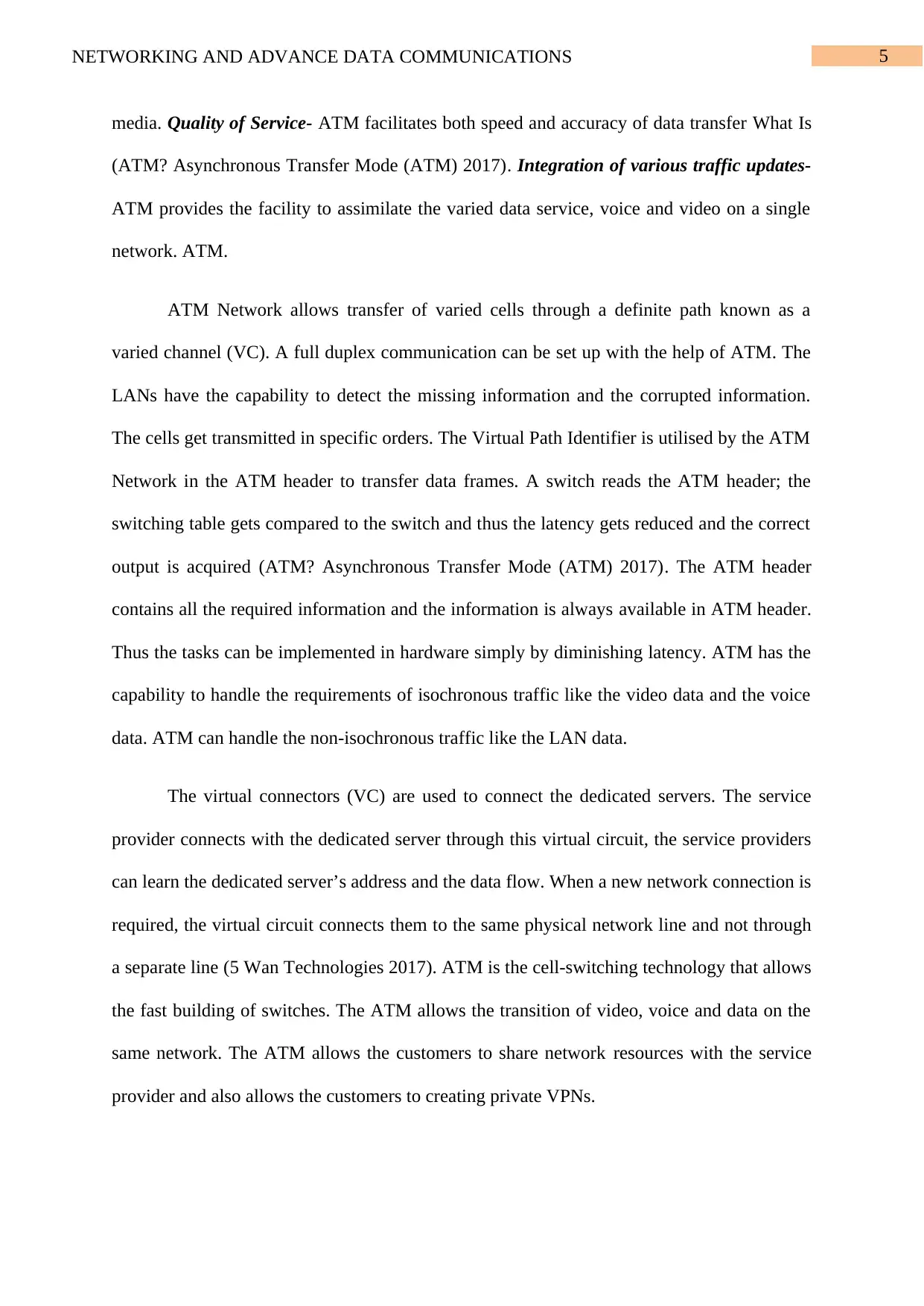
5NETWORKING AND ADVANCE DATA COMMUNICATIONS
media. Quality of Service- ATM facilitates both speed and accuracy of data transfer What Is
(ATM? Asynchronous Transfer Mode (ATM) 2017). Integration of various traffic updates-
ATM provides the facility to assimilate the varied data service, voice and video on a single
network. ATM.
ATM Network allows transfer of varied cells through a definite path known as a
varied channel (VC). A full duplex communication can be set up with the help of ATM. The
LANs have the capability to detect the missing information and the corrupted information.
The cells get transmitted in specific orders. The Virtual Path Identifier is utilised by the ATM
Network in the ATM header to transfer data frames. A switch reads the ATM header; the
switching table gets compared to the switch and thus the latency gets reduced and the correct
output is acquired (ATM? Asynchronous Transfer Mode (ATM) 2017). The ATM header
contains all the required information and the information is always available in ATM header.
Thus the tasks can be implemented in hardware simply by diminishing latency. ATM has the
capability to handle the requirements of isochronous traffic like the video data and the voice
data. ATM can handle the non-isochronous traffic like the LAN data.
The virtual connectors (VC) are used to connect the dedicated servers. The service
provider connects with the dedicated server through this virtual circuit, the service providers
can learn the dedicated server’s address and the data flow. When a new network connection is
required, the virtual circuit connects them to the same physical network line and not through
a separate line (5 Wan Technologies 2017). ATM is the cell-switching technology that allows
the fast building of switches. The ATM allows the transition of video, voice and data on the
same network. The ATM allows the customers to share network resources with the service
provider and also allows the customers to creating private VPNs.
media. Quality of Service- ATM facilitates both speed and accuracy of data transfer What Is
(ATM? Asynchronous Transfer Mode (ATM) 2017). Integration of various traffic updates-
ATM provides the facility to assimilate the varied data service, voice and video on a single
network. ATM.
ATM Network allows transfer of varied cells through a definite path known as a
varied channel (VC). A full duplex communication can be set up with the help of ATM. The
LANs have the capability to detect the missing information and the corrupted information.
The cells get transmitted in specific orders. The Virtual Path Identifier is utilised by the ATM
Network in the ATM header to transfer data frames. A switch reads the ATM header; the
switching table gets compared to the switch and thus the latency gets reduced and the correct
output is acquired (ATM? Asynchronous Transfer Mode (ATM) 2017). The ATM header
contains all the required information and the information is always available in ATM header.
Thus the tasks can be implemented in hardware simply by diminishing latency. ATM has the
capability to handle the requirements of isochronous traffic like the video data and the voice
data. ATM can handle the non-isochronous traffic like the LAN data.
The virtual connectors (VC) are used to connect the dedicated servers. The service
provider connects with the dedicated server through this virtual circuit, the service providers
can learn the dedicated server’s address and the data flow. When a new network connection is
required, the virtual circuit connects them to the same physical network line and not through
a separate line (5 Wan Technologies 2017). ATM is the cell-switching technology that allows
the fast building of switches. The ATM allows the transition of video, voice and data on the
same network. The ATM allows the customers to share network resources with the service
provider and also allows the customers to creating private VPNs.
⊘ This is a preview!⊘
Do you want full access?
Subscribe today to unlock all pages.

Trusted by 1+ million students worldwide
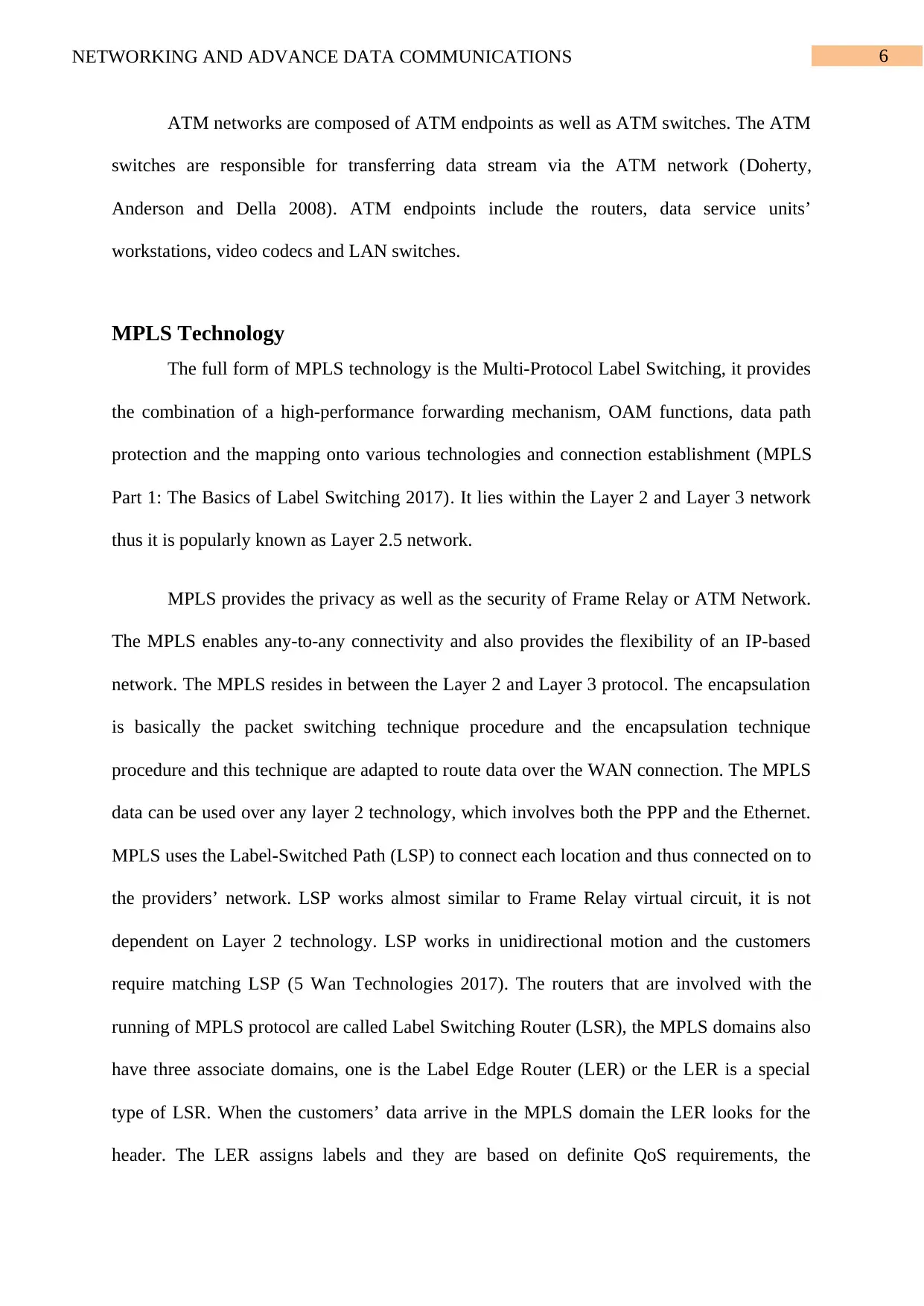
6NETWORKING AND ADVANCE DATA COMMUNICATIONS
ATM networks are composed of ATM endpoints as well as ATM switches. The ATM
switches are responsible for transferring data stream via the ATM network (Doherty,
Anderson and Della 2008). ATM endpoints include the routers, data service units’
workstations, video codecs and LAN switches.
MPLS Technology
The full form of MPLS technology is the Multi-Protocol Label Switching, it provides
the combination of a high-performance forwarding mechanism, OAM functions, data path
protection and the mapping onto various technologies and connection establishment (MPLS
Part 1: The Basics of Label Switching 2017). It lies within the Layer 2 and Layer 3 network
thus it is popularly known as Layer 2.5 network.
MPLS provides the privacy as well as the security of Frame Relay or ATM Network.
The MPLS enables any-to-any connectivity and also provides the flexibility of an IP-based
network. The MPLS resides in between the Layer 2 and Layer 3 protocol. The encapsulation
is basically the packet switching technique procedure and the encapsulation technique
procedure and this technique are adapted to route data over the WAN connection. The MPLS
data can be used over any layer 2 technology, which involves both the PPP and the Ethernet.
MPLS uses the Label-Switched Path (LSP) to connect each location and thus connected on to
the providers’ network. LSP works almost similar to Frame Relay virtual circuit, it is not
dependent on Layer 2 technology. LSP works in unidirectional motion and the customers
require matching LSP (5 Wan Technologies 2017). The routers that are involved with the
running of MPLS protocol are called Label Switching Router (LSR), the MPLS domains also
have three associate domains, one is the Label Edge Router (LER) or the LER is a special
type of LSR. When the customers’ data arrive in the MPLS domain the LER looks for the
header. The LER assigns labels and they are based on definite QoS requirements, the
ATM networks are composed of ATM endpoints as well as ATM switches. The ATM
switches are responsible for transferring data stream via the ATM network (Doherty,
Anderson and Della 2008). ATM endpoints include the routers, data service units’
workstations, video codecs and LAN switches.
MPLS Technology
The full form of MPLS technology is the Multi-Protocol Label Switching, it provides
the combination of a high-performance forwarding mechanism, OAM functions, data path
protection and the mapping onto various technologies and connection establishment (MPLS
Part 1: The Basics of Label Switching 2017). It lies within the Layer 2 and Layer 3 network
thus it is popularly known as Layer 2.5 network.
MPLS provides the privacy as well as the security of Frame Relay or ATM Network.
The MPLS enables any-to-any connectivity and also provides the flexibility of an IP-based
network. The MPLS resides in between the Layer 2 and Layer 3 protocol. The encapsulation
is basically the packet switching technique procedure and the encapsulation technique
procedure and this technique are adapted to route data over the WAN connection. The MPLS
data can be used over any layer 2 technology, which involves both the PPP and the Ethernet.
MPLS uses the Label-Switched Path (LSP) to connect each location and thus connected on to
the providers’ network. LSP works almost similar to Frame Relay virtual circuit, it is not
dependent on Layer 2 technology. LSP works in unidirectional motion and the customers
require matching LSP (5 Wan Technologies 2017). The routers that are involved with the
running of MPLS protocol are called Label Switching Router (LSR), the MPLS domains also
have three associate domains, one is the Label Edge Router (LER) or the LER is a special
type of LSR. When the customers’ data arrive in the MPLS domain the LER looks for the
header. The LER assigns labels and they are based on definite QoS requirements, the
Paraphrase This Document
Need a fresh take? Get an instant paraphrase of this document with our AI Paraphraser
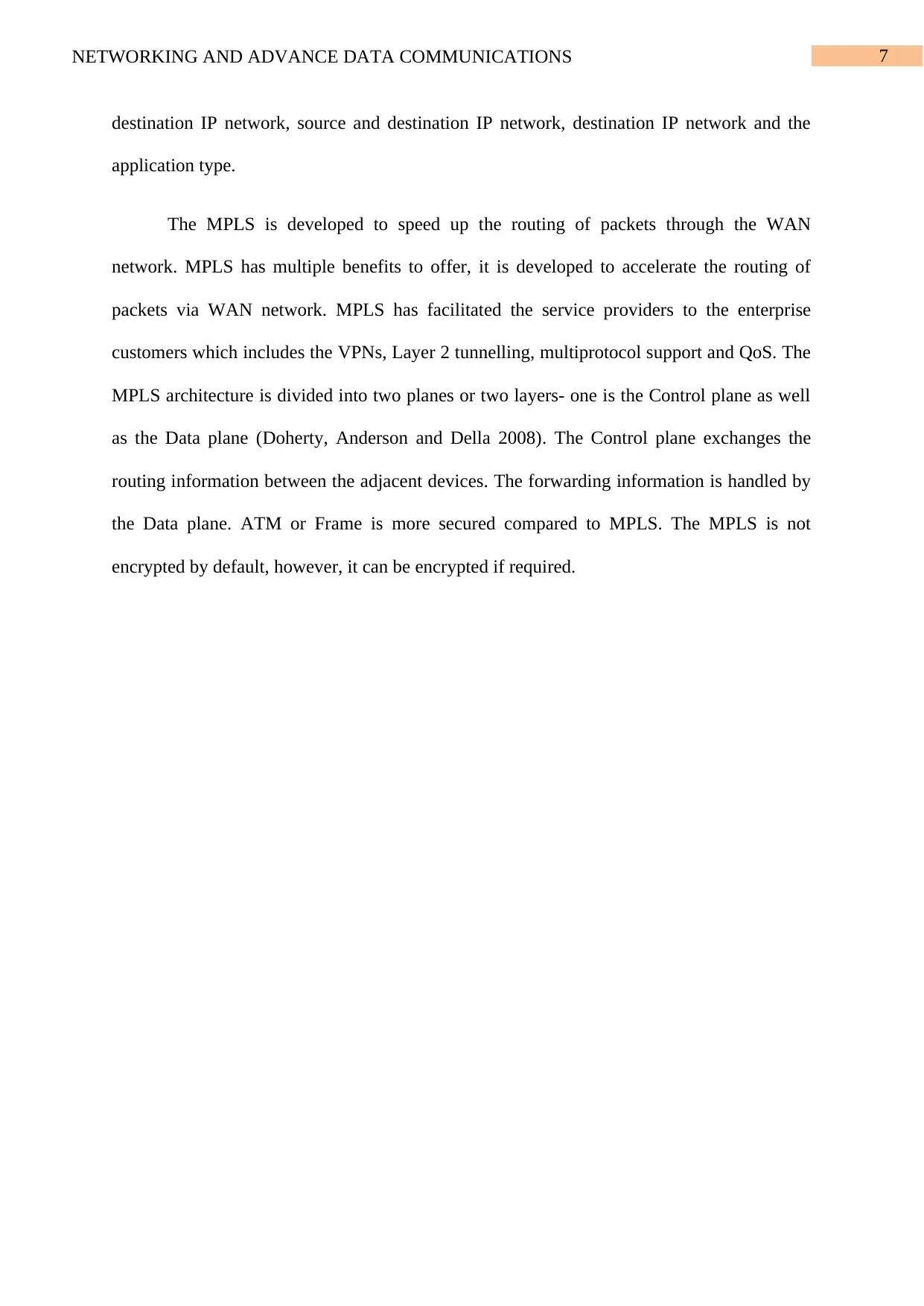
7NETWORKING AND ADVANCE DATA COMMUNICATIONS
destination IP network, source and destination IP network, destination IP network and the
application type.
The MPLS is developed to speed up the routing of packets through the WAN
network. MPLS has multiple benefits to offer, it is developed to accelerate the routing of
packets via WAN network. MPLS has facilitated the service providers to the enterprise
customers which includes the VPNs, Layer 2 tunnelling, multiprotocol support and QoS. The
MPLS architecture is divided into two planes or two layers- one is the Control plane as well
as the Data plane (Doherty, Anderson and Della 2008). The Control plane exchanges the
routing information between the adjacent devices. The forwarding information is handled by
the Data plane. ATM or Frame is more secured compared to MPLS. The MPLS is not
encrypted by default, however, it can be encrypted if required.
destination IP network, source and destination IP network, destination IP network and the
application type.
The MPLS is developed to speed up the routing of packets through the WAN
network. MPLS has multiple benefits to offer, it is developed to accelerate the routing of
packets via WAN network. MPLS has facilitated the service providers to the enterprise
customers which includes the VPNs, Layer 2 tunnelling, multiprotocol support and QoS. The
MPLS architecture is divided into two planes or two layers- one is the Control plane as well
as the Data plane (Doherty, Anderson and Della 2008). The Control plane exchanges the
routing information between the adjacent devices. The forwarding information is handled by
the Data plane. ATM or Frame is more secured compared to MPLS. The MPLS is not
encrypted by default, however, it can be encrypted if required.

8NETWORKING AND ADVANCE DATA COMMUNICATIONS
⊘ This is a preview!⊘
Do you want full access?
Subscribe today to unlock all pages.

Trusted by 1+ million students worldwide
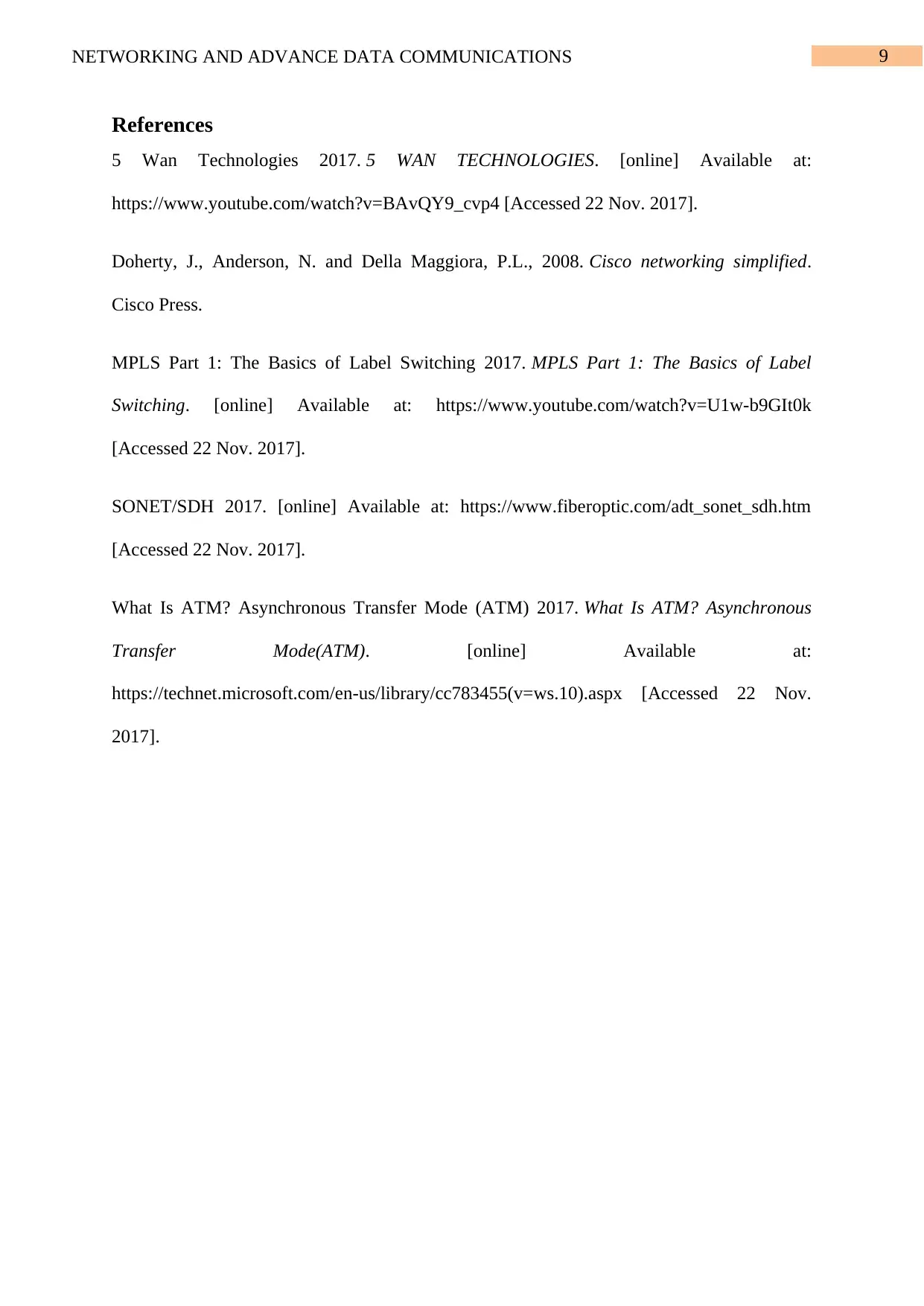
9NETWORKING AND ADVANCE DATA COMMUNICATIONS
References
5 Wan Technologies 2017. 5 WAN TECHNOLOGIES. [online] Available at:
https://www.youtube.com/watch?v=BAvQY9_cvp4 [Accessed 22 Nov. 2017].
Doherty, J., Anderson, N. and Della Maggiora, P.L., 2008. Cisco networking simplified.
Cisco Press.
MPLS Part 1: The Basics of Label Switching 2017. MPLS Part 1: The Basics of Label
Switching. [online] Available at: https://www.youtube.com/watch?v=U1w-b9GIt0k
[Accessed 22 Nov. 2017].
SONET/SDH 2017. [online] Available at: https://www.fiberoptic.com/adt_sonet_sdh.htm
[Accessed 22 Nov. 2017].
What Is ATM? Asynchronous Transfer Mode (ATM) 2017. What Is ATM? Asynchronous
Transfer Mode(ATM). [online] Available at:
https://technet.microsoft.com/en-us/library/cc783455(v=ws.10).aspx [Accessed 22 Nov.
2017].
References
5 Wan Technologies 2017. 5 WAN TECHNOLOGIES. [online] Available at:
https://www.youtube.com/watch?v=BAvQY9_cvp4 [Accessed 22 Nov. 2017].
Doherty, J., Anderson, N. and Della Maggiora, P.L., 2008. Cisco networking simplified.
Cisco Press.
MPLS Part 1: The Basics of Label Switching 2017. MPLS Part 1: The Basics of Label
Switching. [online] Available at: https://www.youtube.com/watch?v=U1w-b9GIt0k
[Accessed 22 Nov. 2017].
SONET/SDH 2017. [online] Available at: https://www.fiberoptic.com/adt_sonet_sdh.htm
[Accessed 22 Nov. 2017].
What Is ATM? Asynchronous Transfer Mode (ATM) 2017. What Is ATM? Asynchronous
Transfer Mode(ATM). [online] Available at:
https://technet.microsoft.com/en-us/library/cc783455(v=ws.10).aspx [Accessed 22 Nov.
2017].
1 out of 10
Your All-in-One AI-Powered Toolkit for Academic Success.
+13062052269
info@desklib.com
Available 24*7 on WhatsApp / Email
![[object Object]](/_next/static/media/star-bottom.7253800d.svg)
Unlock your academic potential
Copyright © 2020–2025 A2Z Services. All Rights Reserved. Developed and managed by ZUCOL.